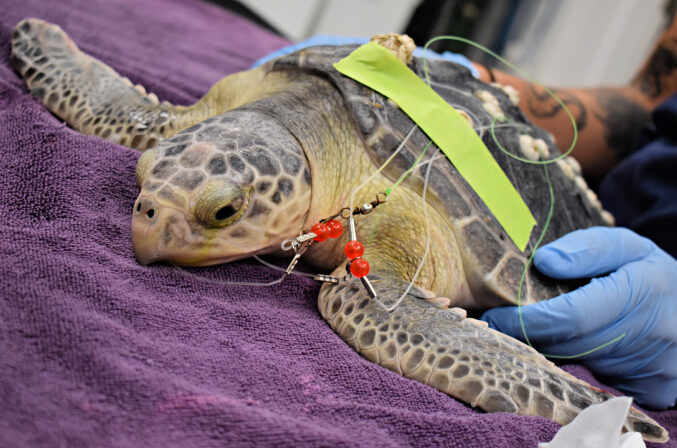It’s a beautiful, sunny summer day in Charleston and you’re cruising on your boat, enjoying every moment. The wind’s in your hair, the sun’s on your face and the salty air is giving you all those endless summer vibes. As you veer toward your favorite fishing spot, you feel a bump. You continue on, thinking nothing of it.
Did you know that sea turtles live in various saltwater environments, and not just the ocean? Potentially, you could find a juvenile loggerhead, green or Kemp’s ridley sea turtle in shallow waters in the Charleston area such as tidal creeks, inlets and estuaries. Meanwhile, from May to October, adult female loggerheads are normally found just offshore.
So, when you felt that bump on your boat ride, was it really nothing or did you actually hit a sea turtle?
Boat Strikes
Unfortunately, watercraft strikes are the number one cause of sea turtle mortality in South Carolina. Typically, boat strike wounds on sea turtles consist of two separate parts. Upon impact with the sea turtle, the boat’s propeller turns and usually makes three parallel, evenly spaced wounds across the carapace, or shell. The skeg, part of the vessel that protects the propeller, intersects those parallel wounds with a separate, horizontal injury that creates a strike-through pattern on the shell. There are cases where the third propeller wound actually removes a portion of the carapace. With these types of wounds, there’s a high possibility that a sea turtle’s lungs can be penetrated and will no longer hold air, therefore filling with water. The propeller can also penetrate the digestive system of the sea turtle, causing a severe bacterial infection if the turtle survives the initial boat strike. In addition to lung or gastrointestinal damage, head and spinal trauma are also a likely outcome in these types of injuries.
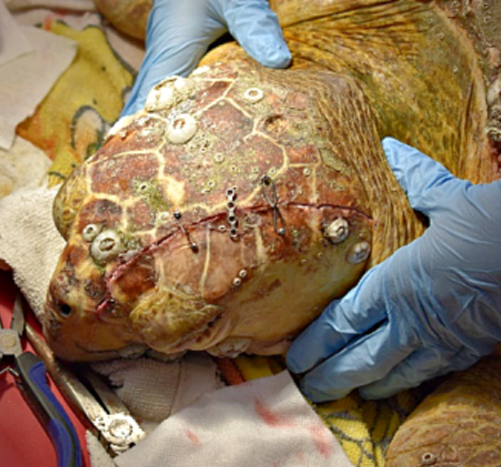 Harry Potter is a loggerhead sea turtle that came to our Care Center after stranding at Murrells Inlet, South Carolina.
Harry Potter is a loggerhead sea turtle that came to our Care Center after stranding at Murrells Inlet, South Carolina.In our Sea Turtle Care Center™, we work with the South Carolina Department of Natural Resources (SCDNR), along with their stranding response volunteers and permit holders, to admit sea turtles that have boat strike injuries and require treatment. Initially, a kind citizen or volunteer will call the SCDNR hotline (1(800) 922-5431) to report an injured sea turtle. From there, SCDNR coordinates with those individuals to transport the animal to our Care Center for evaluation and treatment. Overall, our Care Center and vet staff treat a handful of boat strike patients each summer.
A disproportionate amount of boat strike injuries occur in adult female sea turtles that come ashore to nest, as was the case with a former patient of ours, Angel Oak. A mature female loggerhead, Angel Oak came to us in July of 2020 with a severe boat strike injury to her rear carapace. An ultrasound revealed numerous shelled eggs and egg follicles, confirming that she was mostly likely in the area to nest when she was hit by the vessel.
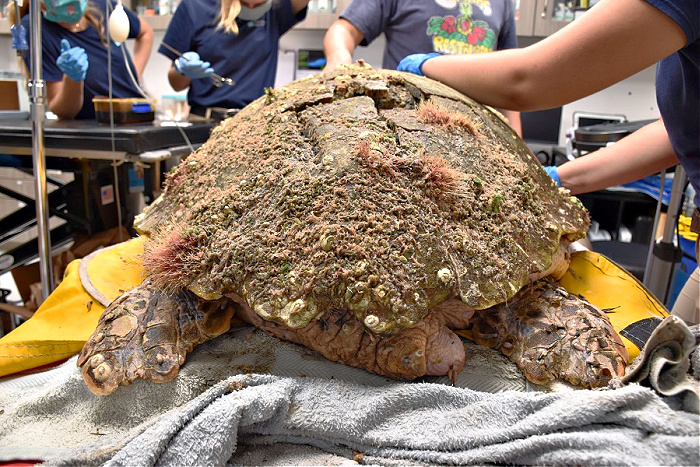 Angel Oak was a 258-pound nesting female who was struck by a boat in July 2020. On her carapace, you can see the propeller strikes as well as the horizontal strike from the skeg of the boat.
Angel Oak was a 258-pound nesting female who was struck by a boat in July 2020. On her carapace, you can see the propeller strikes as well as the horizontal strike from the skeg of the boat.If you’re out on the water and hit a sea turtle (or other marine animal), you can help by doing these small, simple measures that will have a profound impact:
- Wear polarized sunglasses — these lenses help reduce glare from the water, allowing you to see more clearly
- Abide by wake zones, and go slow to allow a sea turtle (and other marine life) to move out of the way
- Assign a passenger as your wildlife watcher — this person can help avoid boat strikes
- If you see an injured sea turtle, immediately call SCDNR at 1(800) 922-5431
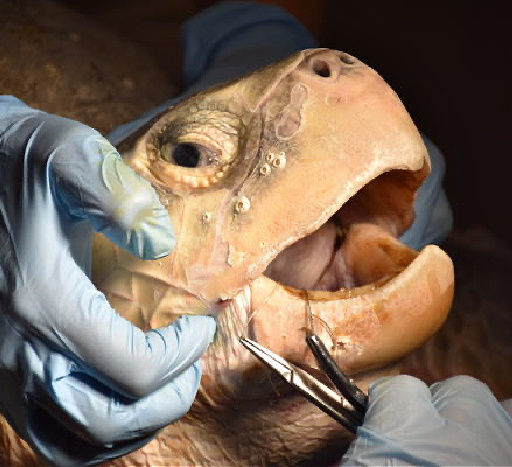 Staff veterinarians work to remove monofilament fishing line from Peach, an adult Kemp's ridley sea turtle.
Staff veterinarians work to remove monofilament fishing line from Peach, an adult Kemp's ridley sea turtle.Hook and Line
At the Care Center, our team sees a large amount of hook and line injuries. Unfortunately, these types of injuries are one of the biggest threats to the most endangered sea turtle species: the Kemp’s ridley sea turtle.
Kemp’s ridley sea turtles are often captured in fishing gear, including hook and line, trawls, gill nets and dredging. Often, a sea turtle will become caught on hook and line because the bait is either shrimp or squid (a favorite food of sea turtles) or the animal has underlying issues and is scavenging for food.
Peach, an adult Kemp’s ridley sea turtle previously treated in the Care Center, had monofilament wrapped around her front flipper, her neck and absorbed into her intestines. Thankfully no hooks were present, but the Aquarium’s vet team removed 120 centimeters of monofilament from Peach’s intestines! This monofilament line is on display just outside of Zucker Family Sea Turtle Recovery™ in our Respond Gallery, sponsored by Ingevity. This space serves as a powerful reminder to keep our waterways clean of marine debris and remain vigilant of wildlife during recreational activities.
While hooking a sea turtle can be alarming, there are simple steps you can take to ensure the animal receives the help it needs:
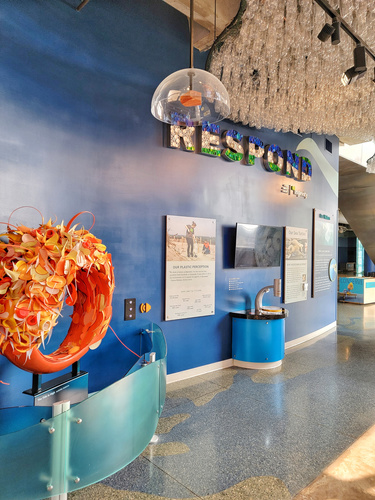 Make sure to walk through our Respond Gallery, sponsored by Ingevity, on your next visit!
Make sure to walk through our Respond Gallery, sponsored by Ingevity, on your next visit!- Immediately call SCDNR at 1(800) 922-5431
- Do not cut the line — having the line to work with makes it easier for our vet staff to remove the hook
- Do not release the sea turtle into the body of water
- If you can, use a dip net to bring the turtle onto land or the boat (with the approval of the SCDNR representative on the phone)
- If possible, stay with the animal until SCDNR arrives
With boat strikes and hook and line injuries accounting for a third of our cases in the Care Center alone since 2000, organizations like SCDNR and the Aquarium are doing everything we can to protect and conserve these animals — and you can help, too.
Next time you’re out on the water or fishing with your friends, remember to practice our simple tips to protect sea turtles and ensure they are here for generations to come.
A special thank you to our experts, Dr. Jamie Torres, director of veterinary care, and Cait Crosby, senior sea turtle biologist, for their time and knowledge in creating this blog.
Do you have another question for our experts?
Published May 31, 2022


